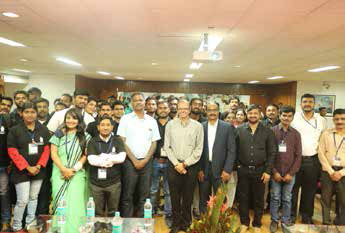Recent whirlwind trip to Chennai for the CII National Council and Mangalore to do the Convocation address at NITK Suratkal opened my eyes even more to the opportunities and challenges that face us
 Ganesh Natarajan with rural entrepreneurs in Pune
Ganesh Natarajan with rural entrepreneurs in PuneA number of friends have asked me what makes me busier than ever and travel twice as much after leaving a full-time CEO role in 2016 and doing a bunch of entrepreneurial and nation-building work. The answer is simple—when your canvas gets expanded and the paint on your palette is overflowing, there are so many new pictures to paint that twenty-four hours a day don’t seem to be enough! And a recent whirlwind trip to Chennai for the CII National Council and Mangalore to do the Convocation address at NITK Suratkal opened my eyes even more to the opportunities and challenges that face us!
The mood of the corporate sector in our country is one of cautious optimism. There is hope that the nadir of GDP growth at 5.7 per cent has been reached and once the short-term stress of demonetisation and GST is behind us, the country can climb back to an eight per cent growth environment for a sustained period of time. The short-term slowdown reflects sharp deceleration in goods exports and moderation in consumption growth and some anticipated inventory destocking ahead of GST implementation in July, all of which should be temporary.
The green shoots of growth are already visible with manufacturing sector’s growth improving marginally to 3.1 per cent with electricity and mining boosting the growth of industrial production. Capital goods output also rose for the first time this year and both consumer durables and non-durables, after a normal monsoon in the country continue to perform well. And the external environment shows positive signs too with global growth projections upgraded to 3.6 per cent this year and 3.7 per cent next year, well above the 2016 actual figure of 3.2 percent.
India is expected to regain its position as the fastest-growing major economy in 2018, a projection that augurs well for job creation and new opportunities for the hundreds of millions of young job seekers who expect that their country will give them the opportunity to do better than the previous generations, which is often the best indicator of upward movement of an economy. One concern, which I shared with the large assembly of academicians, students and parents in NITK is the impact that new developments in artificial intelligence, machine learning, robotics and robotic process automation can have on traditional jobs. New jobs there will be aplenty! Just in IT, a NASSCOM study has identified opportunities in eight new areas including Analytics, Internet of Things and Mixed Reality which includes both Augmented and Virtual Reality.
The jobs of the future will be a heady mix of storytelling, visual and sound effects to make mixed reality a success and will need people with the ability to work with cyber-physical processes and big data emerging from multiple sources in the environment. A McKinsey commentary on the new manufacturing environment with Industry 4.0 gives examples of automated oxygen fluctuation detection in a South African mine, augmented reality enabled picking efficiency transformation in large warehouses and shop floor supervisors of the future armed with the skills to work with families of robots and self-healing machines that need less of operation and more of coordination. The future of the car industry might actually see designs crowd-sourced from potential buyers and converted to a drive-away model through 3D printing and instantaneous robotic assembly. As one bright student correctly mused, is anything I have learnt in the last four years going to prepare me for these changes? The answer is—you have the engineering discipline to understand new concepts and learn new skills that will enable you to cope and succeed in the new world but you need to be innovative and quick to adapt even as the country and the world transform at an extraordinary pace.
India is expected to regain its position as the fastest -growing major economy in 2018, a projection that augurs well for job creation
These rapid changes will also necessitate a new economic and policy philosophy for the new India. No longer can we expect a mandarin sitting in Delhi to develop a precise mathematical model for the economy, for a specific industry or indeed for anything to do with our work and life. What will be needed are individuals and organisations created and nurtured in a new mode—to be focused on success and yet flexible in their approach who move fast to capture new opportunities and face the myriad challenges that will come up on the way. All this in an environment which continues to be friendly and fun. Yes, our mantra of 5F World—Fast Focused Flexible Friendly and Fun has never been more needed than it is today!
And finally returning to the subject of being busier than ever in new vocations, my role model in this regard is good friend and legendary film personality Amol Palekar. After enormous successes in theater, film acting, direction and production, he turned his attention or rather returned to an old love, painting last year and has been truly prolific with his recent exhibition in the USA being a sellout success. India needs more of Amol, Sandhya and their ilk to keep breaking new ground if we are to make this the land of our dreams by 2022. Mera Bharat Mahaan!
Ganesh Natarajan